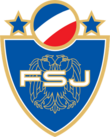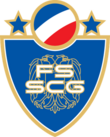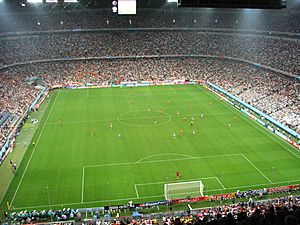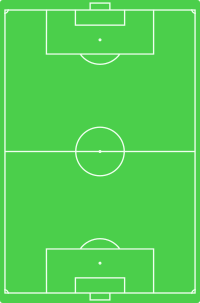Serbia and Montenegro national football team facts for kids
| to 1992–2006 | |||
|---|---|---|---|
  |
|||
| Nickname(s) | Plavi / Плави (The Blues) |
||
| Association | Football Association of Serbia and Montenegro (2003–2006) Football Association of Yugoslavia (1992–2003) |
||
| Confederation | UEFA (Europe) | ||
| Head coach | Ilija Petković (last) | ||
| Captain | Dejan Stanković (last) | ||
| Most caps | Savo Milošević (101) | ||
| Top scorer | Savo Milošević (38) | ||
| FIFA code | SCG (2003–2006) FRY (1992–2003) |
||
|
|||
| FIFA ranking | |||
| Highest | 6 (December 1998) | ||
| Lowest | 101 (December 1994) | ||
| Elo ranking | |||
| Highest | 4 (June 1998) | ||
| Lowest | 39 (June 2006) | ||
| First international | |||
(Porto Alegre, Brazil; 23 December 1994) (Podgorica, Serbia and Montenegro; 12 February 2003) |
|||
| Biggest win | |||
(Toftir, Faroe Islands; 6 October 1996) (Belgrade, Serbia and Montenegro; 13 October 2004) |
|||
| Biggest defeat | |||
(Gelsenkirchen, Germany; 16 June 2006) (Rotterdam, Netherlands; 25 June 2000) (Prague, Czech Republic; 6 September 2002) |
|||
| World Cup | |||
| Appearances | 2 (first in 1998) | ||
| Best result | Round of 16 (1998) | ||
| European Championship | |||
| Appearances | 1 (first in 2000) | ||
| Best result | Quarter-finals (2000) | ||
The Serbia and Montenegro national football team was a football team that played for the country of Serbia and Montenegro. Before 2003, it was known as the FR Yugoslavia national football team when the country was called the Federal Republic of Yugoslavia.
This team was managed by the Football Association of Serbia and Montenegro. In 2006, Montenegro became an independent country. Because of this, the football team split into two new teams: the Serbia national football team and the Montenegro national football team.
Even though the country changed, FIFA and UEFA (the main football organizations) decided that the Serbia and Montenegro team was the direct continuation of the older Yugoslav national teams. This meant they could keep the history and records of those teams.
Contents
History of the Team
Early Years (1994–1998)
The country known as the Federal Republic of Yugoslavia started on April 28, 1992. However, its sports teams were not allowed to play in international events. This was due to rules from FIFA because of conflicts happening in the region.
So, the national team played its first game only on December 23, 1994. It was a friendly match against Brazil in Brazil, which they lost 2–0. This was the first team made up only of players from Serbia and Montenegro. Slobodan Santrač, a former player, became the team's first manager.
Because of international rules, the team could not play in the 1994 FIFA World Cup qualification or the UEFA Euro 1996 qualifying games.
On March 31, 1995, the team won its first official game. It was a friendly match against Uruguay, played in Belgrade. Savo Milošević scored the first goal for the team in this 1–0 win. A little over a year later, they won their first World Cup qualifying match, beating the Faroe Islands 3–1. They also had their biggest win ever against the Faroe Islands, winning 8–1.
FR Yugoslavia finished second in their qualifying group, behind Spain. This meant they had to play in a special play-off round to qualify for the World Cup. They played against Hungary and won easily, with scores of 7–1 and 5–0. This big 12–1 win helped them get into their first World Cup as a new country.
1998 FIFA World Cup Journey
The 1998 World Cup was held in France. Many experts thought FR Yugoslavia could do very well, maybe even reach the semi-finals. This was because they had many talented players who played for big European clubs.
In the group stage, they were with Germany, the United States, and Iran. Yugoslavia won their first game 1–0 against Iran. Their next match was a 2–2 draw against Germany, after being ahead 2–0. They then beat the United States 1–0. Yugoslavia finished second in their group.
In the Round of 16, Yugoslavia played against the Netherlands. The Netherlands scored first, but Yugoslavia equalized with a goal from Slobodan Komljenović. Later, Yugoslavia had a penalty kick, but Predrag Mijatović hit the crossbar. In the last moments of the game, the Netherlands scored, winning 2–1. This ended Yugoslavia's World Cup journey.
Euro 2000 Performance
For the Euro 2000 qualifiers, Yugoslavia was in a group with Croatia. These were the first matches between the two teams since the breakup of Yugoslavia.
The team started well, winning against Ireland and Malta. A home game against Malta had to be played in Greece because of conflicts in Yugoslavia at the time. They still won 4–1. The first match against Croatia in Belgrade ended in a 0–0 draw. After a loss to Ireland, Yugoslavia won both games against Macedonia. In their final game against Croatia in Zagreb, a 2–2 draw was enough for Yugoslavia to qualify for Euro 2000.
In the Euro 2000 tournament, Yugoslavia was in Group C with Spain, Norway, and Slovenia. In their first match, Slovenia took a surprising 3–0 lead, but Yugoslavia fought back to draw 3–3. They then beat Norway 1–0. In their last group match against Spain, Yugoslavia led three times but lost 4–3 in the final minutes. Despite the loss, they finished second in the group and moved to the next round.
In the quarter-finals, Yugoslavia played against the Netherlands again. This time, the Netherlands won easily, 6–1.
One of the best players for Yugoslavia in the tournament was Savo Milošević. He was one of the top scorers, with five goals.
Challenges in 2002 World Cup Qualifiers
The 2002 World Cup qualifiers were tough for Yugoslavia. They failed to qualify for a major tournament for the first time since returning to international football. There were many changes in the country's football association.
The team had a new coach, Ilija Petković, who left after only one match. Milovan Đorić took over, but the team only managed two draws and a home loss to Russia. After more changes, Dejan Savićević became the coach. The team improved but still couldn't qualify, finishing third in their group.
The Serbia and Montenegro Era (2003–2006)
After some political changes in the country, Ilija Petković became the coach again for the newly named Serbia and Montenegro team.
For the Euro 2004 qualifiers, the team struggled. Even though they drew both matches against strong team Italy and won against Wales, they failed to qualify. This was mainly due to poor results against Azerbaijan.
However, Serbia and Montenegro did qualify for the 2006 World Cup. They finished first in their qualifying group without losing a single game, even ahead of Spain. Their defense was amazing, letting in only one goal in ten matches. This was the best defensive record of all 51 teams in the qualifiers. The defense, known as the "Famous Four," included Nemanja Vidić, Mladen Krstajić, Goran Gavrančić, and Ivica Dragutinović, with Dragoslav Jevrić as goalkeeper.

On June 3, 2006, Montenegro declared its independence from Serbia. Since the World Cup was about to start, it was decided that the Serbia and Montenegro team would still play in the tournament. The split into separate teams for Serbia and Montenegro would happen after the tournament. So, the team played representing a country that no longer existed. Only one player from Montenegro, goalkeeper Dragoslav Jevrić, was in the squad.
In the World Cup group stage, Serbia and Montenegro lost their first game 1–0 to the Netherlands. They then lost their second match to Argentina 6–0. This was the team's biggest loss ever. With these two losses, Serbia and Montenegro could not move on to the next round. In their final group match against the Ivory Coast, they lost 3–2, even after leading 2–0. This meant they finished the World Cup with three losses and no wins.
After the Team Split
A week after their last World Cup match, the Football Association of Montenegro asked to join UEFA as a separate member. The Football Association of Serbia took over Serbia and Montenegro's place in UEFA and FIFA. The new Serbia national football team played its first game in August 2006. The Montenegro national football team played its first international match in March 2007.
Kit History
Kit Supplier
| Kit supplier | Period |
|---|---|
| 1994–2001 | |
| 2002–2006 |
FR Yugoslavia Kits
|
1996 home
|
1998 WC home
|
1998 WC away
|
Euro 2000 home
|
2002 home
|
2002 away
|
Serbia and Montenegro Kits
|
2004 Home
|
2004 Away
|
2006 WC Home
|
2006 WC Away
|
Competitive Records
FIFA World Cup
Here's how the team performed in the FIFA World Cup tournaments:
- 1930 to 1990 – See Yugoslavia
- 1994 – Not allowed to play due to international rules (as FR Yugoslavia)
- 1998 – Reached Round 2 (as FR Yugoslavia)
- 2002 – Did not qualify (as FR Yugoslavia)
- 2006 – Reached Round 1 (as Serbia and Montenegro)
| FIFA World Cup record | Qualification record | |||||||||||||||
|---|---|---|---|---|---|---|---|---|---|---|---|---|---|---|---|---|
| as |
as |
|||||||||||||||
| Year | Round | Position | Pld | W | D | L | GF | GA | Squads | Pld | W | D | L | GF | GA | |
| Semi-finals | 4th | 3 | 2 | 0 | 1 | 7 | 7 | Squad | Invited | |||||||
| Did not qualify | 2 | 0 | 1 | 1 | 3 | 4 | ||||||||||
| 2 | 1 | 0 | 1 | 1 | 4 | |||||||||||
| as |
as |
|||||||||||||||
| Group stage | 5th | 3 | 2 | 0 | 1 | 7 | 3 | Squad | 5 | 3 | 2 | 0 | 16 | 6 | ||
| Quarter-finals | 7th | 3 | 1 | 1 | 1 | 2 | 3 | Squad | 4 | 4 | 0 | 0 | 4 | 0 | ||
| Quarter-finals | 5th | 4 | 1 | 2 | 1 | 7 | 7 | Squad | 4 | 2 | 2 | 0 | 7 | 2 | ||
| Fourth place | 4th | 6 | 3 | 0 | 3 | 10 | 7 | Squad | 4 | 3 | 1 | 0 | 11 | 4 | ||
| Did not qualify | 6 | 3 | 1 | 2 | 10 | 8 | ||||||||||
| 6 | 3 | 1 | 2 | 19 | 7 | |||||||||||
| Quarter-finals | 7th | 6 | 1 | 2 | 3 | 12 | 7 | Squad | 5 | 3 | 2 | 0 | 8 | 4 | ||
| Did not qualify | 4 | 1 | 0 | 3 | 6 | 8 | ||||||||||
| Group stage | 16th | 3 | 1 | 1 | 1 | 2 | 2 | Squad | 8 | 6 | 1 | 1 | 22 | 7 | ||
| Did not qualify | 8 | 3 | 2 | 3 | 7 | 8 | ||||||||||
| Quarter-finals | 5th | 5 | 3 | 1 | 1 | 8 | 6 | Squad | 8 | 6 | 2 | 0 | 16 | 6 | ||
| as |
as |
|||||||||||||||
| Banned | Disqualified | |||||||||||||||
| Round of 16 | 10th | 4 | 2 | 1 | 1 | 5 | 4 | Squad | 12 | 9 | 2 | 1 | 41 | 8 | ||
| Did not qualify | 10 | 5 | 4 | 1 | 22 | 8 | ||||||||||
| as |
as |
|||||||||||||||
| Group stage | 32nd | 3 | 0 | 0 | 3 | 2 | 10 | Squad | 10 | 6 | 4 | 0 | 16 | 1 | ||
| Total | Fourth place | 10/19 | 40 | 16 | 8 | 16 | 62 | 56 | — | 98 | 58 | 25 | 15 | 209 | 85 | |
UEFA European Championship
Here's how the team performed in the European Championship:
- 1960 to 1992 – See Yugoslavia
- 1992 – Qualified, but not allowed to play due to international rules (as FR Yugoslavia)
- 1996 – Not allowed to play (as FR Yugoslavia)
- 2000 – Reached Quarter-finals (as FR Yugoslavia)
- 2004 – Did not qualify (as FR Yugoslavia/Serbia and Montenegro)
Champions Runners-up Third place Fourth place
| UEFA European Championship record | Qualifying record | |||||||||||||||
|---|---|---|---|---|---|---|---|---|---|---|---|---|---|---|---|---|
| as |
as |
|||||||||||||||
| Year | Round | Position | Pld | W | D | L | GF | GA | Squads | Pld | W | D | L | GF | GA | |
| Runners-up | 2nd | 2 | 1 | 0 | 1 | 6 | 6 | Squad | 4 | 2 | 1 | 1 | 9 | 4 | ||
| Did not qualify | 4 | 2 | 1 | 1 | 6 | 5 | ||||||||||
| Runners-up | 2nd | 3 | 1 | 1 | 1 | 2 | 3 | Squad | 6 | 4 | 1 | 1 | 14 | 5 | ||
| 1/4 playoffs | 8 | 3 | 4 | 1 | 7 | 5 | ||||||||||
| Fourth place | 4th | 2 | 0 | 0 | 2 | 4 | 7 | Squad | 8 | 6 | 1 | 1 | 15 | 5 | ||
| Did not qualify | 6 | 4 | 0 | 2 | 14 | 6 | ||||||||||
| Group stage | 8th | 3 | 0 | 0 | 3 | 2 | 10 | Squad | 6 | 3 | 2 | 1 | 12 | 11 | ||
| Did not qualify | 6 | 4 | 0 | 2 | 13 | 9 | ||||||||||
| Banned after qualification | 8 | 7 | 0 | 1 | 24 | 4 | ||||||||||
| as |
as |
|||||||||||||||
| Suspended | Suspended | |||||||||||||||
| Quarter-finals | 8th | 4 | 1 | 1 | 2 | 8 | 13 | Squad | 8 | 5 | 2 | 1 | 18 | 8 | ||
| as |
as |
|||||||||||||||
| Did not qualify | 8 | 3 | 3 | 2 | 11 | 11 | ||||||||||
| Total | Runners-up | 5/12 | 14 | 3 | 2 | 9 | 22 | 39 | — | 72 | 43 | 15 | 14 | 143 | 73 | |
Major Competitions Squads
World Cup
- 1998 World Cup squad
- 2006 World Cup squad
European Championship
- UEFA Euro 2000 squad
Coaches
- Slobodan Santrač (1994 – July 1998)
- Milan Živadinović (August 1998 – 1999)
- Vujadin Boškov (1999 – July 2000)
- Ilija Petković (August 2000 – January 2001)
- Milovan Đorić (February 2001 – May 6, 2001)
- 3-man commission: Dejan Savićević, Vujadin Boškov and Ivan Ćurković (May 6, 2001 – December 2001)
- Dejan Savićević (December 2001 – June 2003)
- Ilija Petković (July 2003 – June 2006)
Honours
Friendly Tournaments
- Lunar New Year Cup
- Champions (1): 1995
- Millennium Super Cup
- Champions (1): 2001
- Korea Cup
- Runners-up (1): 1997
- Kirin Cup
- Runners-up (1): 2004
Awards
See also
 In Spanish: Selección de fútbol de Serbia y Montenegro para niños
In Spanish: Selección de fútbol de Serbia y Montenegro para niños
- Serbia and Montenegro national football team results


